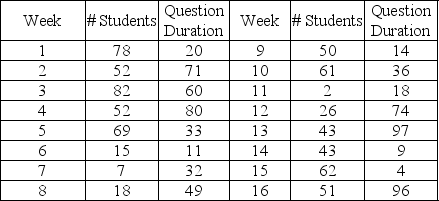Multiple Choice
Table 13-7
A professor dutifully holds six office hours per week as dictated by an archaic policy.Demand for office hours varies wildly as reflected in this historical data.
 The duration of time to answer questions varies independently from the actual demand.Question duration is reflected in this table.
The duration of time to answer questions varies independently from the actual demand.Question duration is reflected in this table.
 Entries in the student demand and question duration tables that reflect a range in demand, i.e., 3-9 students per six hours or 4-9 minutes should be treated as collapsed entries in the table.Thus, a question duration of 4 minutes has a 0.05 probability, a question duration of 5 minutes also has a 0.05 probability, and so on up through 9 minutes and a 0.05 probability.
Entries in the student demand and question duration tables that reflect a range in demand, i.e., 3-9 students per six hours or 4-9 minutes should be treated as collapsed entries in the table.Thus, a question duration of 4 minutes has a 0.05 probability, a question duration of 5 minutes also has a 0.05 probability, and so on up through 9 minutes and a 0.05 probability.
This table contains random numbers for the number of students and duration of question for a 16-week period.
 Use the question duration figure as the time required to answer questions for each student that week, so if three students arrive in week seven and the average duration is ten minutes, the total time spent answering questions that week is thirty minutes.
Use the question duration figure as the time required to answer questions for each student that week, so if three students arrive in week seven and the average duration is ten minutes, the total time spent answering questions that week is thirty minutes.
-What is the number of students that show up in a six-hour period during week 3 according to the information contained in Table 13-7?
A) 9
B) 10
C) 11
D) 12
Correct Answer:

Verified
Correct Answer:
Verified
Q84: Econometric models are typically huge simulations involving
Q85: Table 13-6<br>Paul prepares a variety of Creole
Q86: Paul prepares a variety of Creole and
Q87: Table 13-7<br>A professor dutifully holds six office
Q88: Table 13-1<br>The table below represents the probability
Q89: Table 13-6<br>Paul prepares a variety of Creole
Q91: Many companies use computerized simulation models to
Q92: Table 13-2<br>A new young mother has opened
Q93: Simulation models are designed to generate optimal
Q94: What is the probability of selecting any